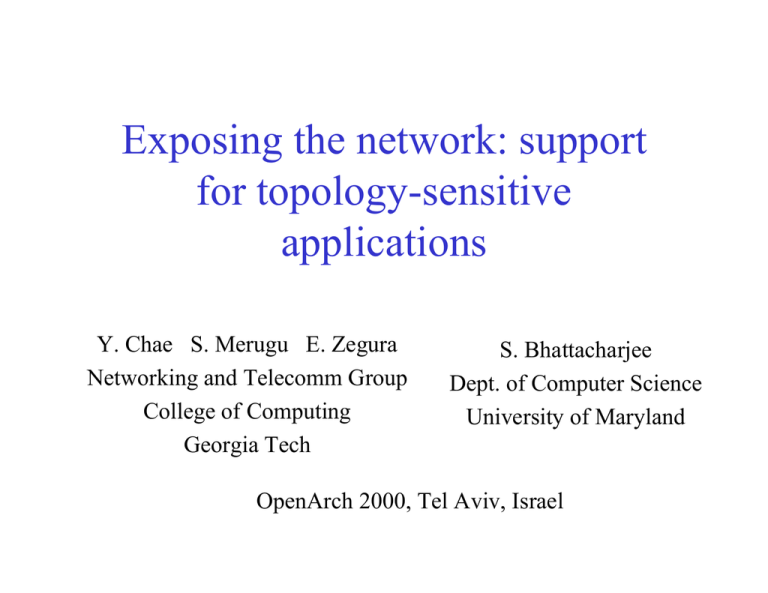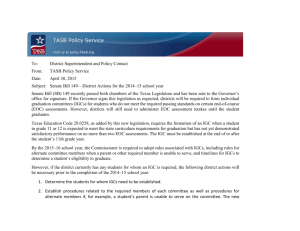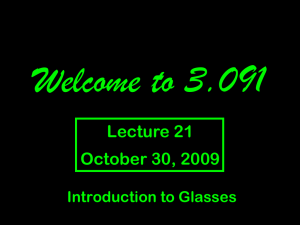Exposing the network: support for topology-sensitive applications
advertisement

Exposing the network: support
for topology-sensitive
applications
Y. Chae S. Merugu E. Zegura
Networking and Telecomm Group
College of Computing
Georgia Tech
S. Bhattacharjee
Dept. of Computer Science
University of Maryland
OpenArch 2000, Tel Aviv, Israel
Motivation
• Repair server placement
– determine locations for mcast
repair servers
• Secure overlay creation
– identify secure links and nodes
Key: requires knowledge of topology
2
Problem statement
• Define service that allows:
– constrained query and synthesis of network
topology information
• Assume:
– nodes maintain attributes for local information
(including link info)
• Restrict:
– computation functionality
– access to node state
3
Outline
•
•
•
•
•
Problem statement
Solution overview
Implementation
Performance results
Conclusions
4
Iterative GCS overview
• Gather
– collect messages on specified
channels
• Compute
– perform computation using
gathered messages, stored
state, node/link attributes
G.i
C.i
S.i
• Scatter
– send message on specified
channels
5
IGCS Specification
• Set of three-tuples: {(G.i, C.i, S.i)}, where
tuple i describes i-th iteration
• G.i, S.i: sets of link descriptors
• C.i: computation function
– may change local state Π (including subsequent
gather and scatter sets) and create output msg
– oMsg ← C({iMsg},Σ.node,Σ.link,Π)
6
Example: path info retrieval (I)
• Iteration 0 (set up)
0
– messages flow from src to dst
– compute downstream path and
establish sets S.0, G.1, S.1
1
• Iteration 1 (work)
– messages flow from dst to src
– compute using message content
and local state (e.g., min)
4
6
src=0, dst=6
7
Example: path info retrieval (II)
• Iteration 0 details:
–
–
–
–
–
copy src msg to out msg
record incoming link as S.1
lookup next hop to dst (h)
record h as G.1and S.0
scatter out msg to S.0
0
1
• Iteration 1 details:
–
–
–
–
wait for message on G.1
copy src msg to out msg
take min of src msg and local state
scatter out msg to S.1
4
6
src=0, dst=6
8
Generalizations
• Multicast tree information retrieval
– change dst unicast address to group address
– assume routing table lookup returns set of
interfaces for multicast tree
• Repair server location
– change computation to check if packet loss on
downstream links exceeds threshold
– record identity of links in reply message
9
Implementation: Background
• CANEs
– execution environment supporting composition
– underlying program (skeleton pkt processing)
– injected programs (customize skeleton)
• Bowman
– active node OS (built over hostOS)
– provides channels, a-flows, state-store,...
– plug: Infocom paper/talk Thursday morning
10
Packet Processing Path
a-flow processing
user code
Bowman
code
input queues
cut-through
packet
classifiers
output queues
input channels
output channels
11
IGCS system architecture
signaling
message
Node A
Node B
IGCS daemon: node-resident; parses signaling
messages, initiates new instance with proper code
IGCS instance: underlying IGCS program and
injected programs for specific activity
12
Underlying program
for (i = 0; i < igcs_get_iteration(); ++i) {
/* Gather Phase */
igcs_get_gather(i, tmp_io);
if (tmp_io->num_ch != 0) {
igcs_install_gather_filter(tmp_io);
cur_in = igcs_gather_msg(tmp_io);
c_Ep(inMsg) = cur_in;
igcs_uninstall_gather_filter(tmp_io);
}
/* Compute Phase */
igcs_raise_slot(Compute);
/* Scatter Phase */
igcs_get_scatter(i, tmp_io);
igcs_scatter_msg(c_Ep(outMsg),tmp_io);
}
13
Injected program
memcpy(tmp_msg, (igcs_msg_t *)igcs_get_sigmsg(),
tmp_sig->len);
i = igcs_next_hop(tmp_msg->src_id);
tmp_io.num_ch = 1;
tmp_io.ch[0] = i;
igcs_set_scatter(1, &tmp_io);
igcs_get_all_vn_channel(&tmp_io);
_igcs_get_diff_channel(&tmp_io, i);
igcs_set_scatter(0, &tmp_io);
igcs_set_gather(1, &tmp_io);
tmp_msg->src_id = net_utils_local_ip_number();
tmp_msg->type = IGCS_SIG;
c_Ip(outMsg) = tmp_msg;
14
Experiment
query
reply
Centralized algorithm
set up
synthesis
IGCS algorithm
15
Effect of link delay
Response Time ( msec)
12000
10000
8000
6000
4000
2000
0
0
2
4
6
8
10
Link Delay ( msec)
IGCS Cold-start
IGCS Warm-start
Centralized
16
Effect of path length
Response Time ( msec )
6000
5000
4000
3000
2000
1000
0
1
2
3
4
5
6
7
8
9
10
11
Path Length ( Hops )
IGCS Cold-start
IGCS Warm-start
Centralized
17
Concluding remarks
• IP provides black box to network topology
• Selectively opening the box makes some
useful functionality possible (or easier)
• Key is to balance flexibility with
performance and security
• Open issues: access control for node and
link state, route changes during
computations, integration w/virtual topos
18






